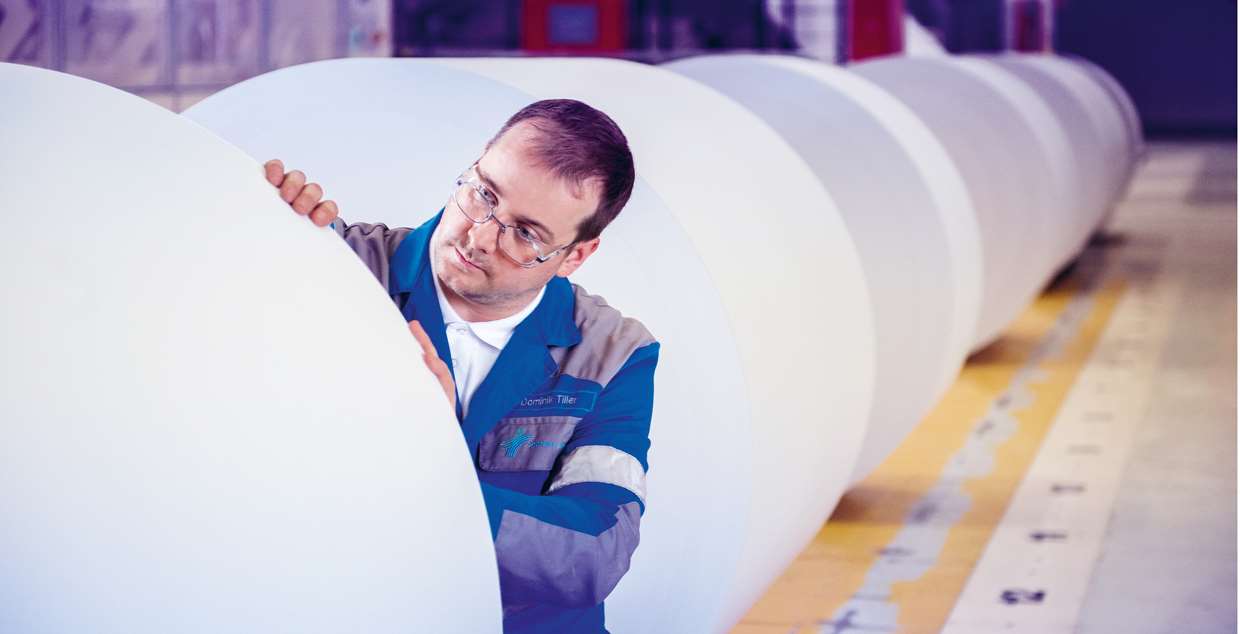Paper
Sales increased, but earnings depressed by higher recovered paper prices

While net sales increased 7.3% to CHF 264.1 million, steep rises in recovered paper prices prompted another negative EBIT result. The division is taking over Papierfabrik Utzenstorf’s recovered paper business and waste paper sorting facility.
Strategy
The geographical market for the producers of newsprint and magazine paper is determined to a large extent by the applicable transport costs. Since these are incorporated into the product’s purchase price, its competitiveness in pricing terms will deteriorate with increasing distance from the customer. The viable delivery range here tends to be up to 800 kilometres from the place of production.
Recovered paper is the most important raw material in Perlen Papier’s paper production. Here, too, the closer the waste paper is recovered to the production site, the lower the transport costs. As a result, paper manufacturing is regionally based, and the supplier with the lowest cost structure will have the best prospects in their sales region. Perlen Papier pursues various measures − in procurement, optimizing production and market cultivation − to further drive its cost leadership.
The Paper Division is strengthening its market position with its acquisition of the customer and recovered paper supply contracts of Papierfabrik Utzenstorf as of 1 January 2018, and is now Switzerland’s sole producer of newsprint and magazine paper. Papierfabrik Utzenstorf, which was manufacturing some 200 000 tonnes of newsprint in its final years, ceased production at the end of 2017. The waste paper volumes recovered from Swiss households are now delivered to the Perlen factory, so most of Perlen Papier’s recovered paper supplies now come from within Switzerland.
Perlen Papier is also continuing to operate the Utzenstorf waste paper sorting facility, which sorts up to 30 000 tonnes of recovered paper and cardboard a year into the two categories. These recovered paper collection and delivery activities are being assimilated into a new company named APS Altpapier Service Schweiz AG. On the sales front, Perlen Papier will now have the opportunity to supply the former customers of Papierfabrik Utzenstorf from 2018. A number of Utzenstorf’s successful paper lines will continue to be produced in Perlen to this end.
Market environment
The structural changes in the European media market continued in 2017. Printed newspapers suffered falling circulations and ranges, as young people in particular elect to receive their news largely online. On a brighter note, the year brought a slight improvement in advertising sales. Retailers especially continue to opt for printed advertising channels. All in all, 2017 saw a 6.9% decline in the demand for newsprint in Western Europe, a far bigger fall than the previous year. By year-end the industry had overcapacities of 0.4 million tonnes on annual capacity of 6.1 million tonnes. The price of newsprint also fell slightly in the course of the year. Various manufacturers have taken capacity out of the market, which should ease these pressures in 2018.
Magazine paper prices came under stronger pressure, owing to a further rise in overcapacities. The 3.7% fall in demand for magazine paper in 2017 was well below the 5% of the previous year. But no capacity was withdrawn on the supply side. By year-end the overcapacities amounted to 0.7 million tonnes.
The procurement markets saw a rise in the price of recovered paper, which increased by more than 10% in the course of the year. The trend is attributable to two factors. First, Asia requires some 28 million tonnes of recovered paper a year and took almost 10 million tonnes of this from Europe; and secondly, the demand for cardboard packagings continues to grow.
Business development
The Paper Division sold 553 660 tonnes of publication paper in 2017, a year-on-year increase of 8.0%. The volumes of newsprint sold were up 6.7% at 380 238 tonnes, while the volumes of magazine papers sold saw a 10.8% increase to 173 422 tonnes. The higher sales volumes boosted net sales, too, which were up 7.3% at CHF 264.1 million. As a result, Perlen Papier now has 35.9% of the Swiss newsprint market and 27.7% of its magazine paper market (compared to 34.7% and 27.8% respectively for 2016). Within Western Europe, Perlen Papier has a 6.2% share of the newsprint market (2016: 5.3%) and a 6.6% share of the magazine paper market (2016: 6.1%).
The division invested some CHF 7.6 million in facilities and in efficiency enhancements in 2017. But the improvements achieved were not sufficient to fully offset the steep rise in recovered paper prices. EBITDA for the year declined to CHF 9.1 million, while EBIT amounted to CHF −12.3 million. Personnel numbers remained virtually unchanged at 345 employees. Around a dozen former employees of Papierfabrik Utzenstorf will join the divisional workforce in 2018.
Outlook
Europe’s demand for publication paper is expected to decline by a further 4% to 7% in 2018. The price of newsprint offered slight signs of recovery at the beginning of the year, but magazine paper prices show little movement. The Paper Division plans investments of some CHF 11.3 million in 2018 to optimize its processes and its production facilities. The higher proportion of recovered paper coming from Swiss sources will lower costs here. And provided prices and currency rates remain stable, the division expects to report higher net sales for 2018 and a return to a black-ink EBIT result.
